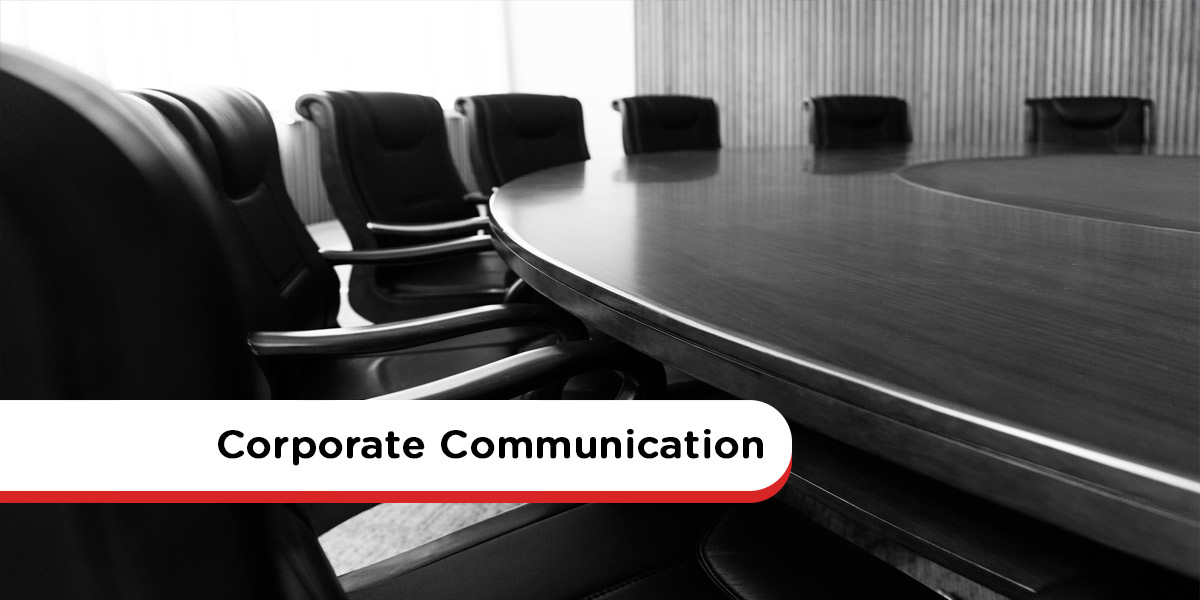
Your New Intranet Starts Here
Streamline communication, boost collaboration, and empower your team with MyHub's intuitive intranet solution.
Book a live demo now and experience the difference.
Take a Quick TourYou may think that corporate communication only matters for big companies and large multinationals. However, corporate communication is vital for business success, regardless of size. Effective corporate communication supports brand identity, engages stakeholders, and bridges gaps between staff and management.
But what does effective corporate communication look like in practice? In this post, we explore everything you need to know, including best practices, practical tips, and real-world examples that can be applied to small and medium enterprises (SMEs).
Whether you’re just starting your corporate communication journey or have encountered challenges along the way, this guide offers actionable insights to help you strengthen your messaging and achieve business goals.
What Is SME Corporate Communication?
Corporate communication is an umbrella term describing any interaction between a company and its internal or external stakeholders. It is commonly divided into two categories: internal and external communications.
Internal Corporate Communication
This includes all messaging and information shared within the organization. From executive updates and managerial guidance to inter-departmental collaboration and casual workplace conversations, internal communication ensures alignment, transparency, and engagement across the team.
External Corporate Communication
External communication refers to public-facing interactions. This includes communications with customers, media, government agencies, regulators, and the broader public. External corporate communication shapes your brand image and informs stakeholders about your products, services, and corporate values.
Types Of SME Corporate Communication
Corporate communication can take several forms, depending on the audience and message. The main types include:
- Written Communication: Includes website content, printed reports, business IM, ad copy, emails, and social media posts.
- Visual Communication: Encompasses logos, graphics, infographics, photos, and other visual branding elements.
- Audio-visual Communication: Covers webinars, conferences, videos, podcasts, and in-person or virtual meetings and events.
Choosing the right communication type depends on your goals, audience, and message complexity.
Examples Of Corporate Communication for SMEs
Corporate communication examples can be grouped into four broad categories, each essential for SMEs looking to establish credibility and engagement.
Media And Public Relations
Media and PR involves messaging with the public and external stakeholders, including the press. Examples include press releases announcing mergers, acquisitions, or corporate social responsibility (CSR) initiatives like volunteering projects or philanthropy programs. Organizational identity, including branding, logos, and mission statements, is a crucial aspect of PR.
Customer Communication And Marketing
Corporate communication aligns closely with marketing to create a cohesive brand identity and promote products or services. This includes website content, newsletters, email campaigns, brochures, and PPC ad copy. The goal is to attract and engage customers while reinforcing your corporate image.
Crisis Communication
When an unexpected event or crisis occurs, corporate communication ensures a consistent and coordinated response. Examples include workplace accidents, product recalls, chemical spills, or lawsuits. Effective crisis communication mitigates reputation damage and ensures stakeholders receive accurate, timely updates.
Internal Communication
Internal communication is vital for keeping employees informed and connected. It supports transparency, reinforces corporate culture, and improves collaboration. Examples include team chat, internal newsletters, onboarding programs, employee handbooks, and SOPs. Ensuring two-way communication channels allows employees to provide feedback and engage effectively.
Communication Skills Required For SMEs
Professionals in corporate communication must possess a diverse skill set to navigate the complexity of internal and external messaging.
Writing Skills
Strong writing skills are essential for crafting clear, concise, and engaging messages tailored to diverse audiences. From blog posts to corporate reports, well-written communication enhances understanding and credibility.
Public Speaking Skills
Corporate communicators are often the face of the organization. Public speaking skills are crucial for presenting confidently, both in person and virtually, to internal teams, clients, or the media.
Research And Analytical Skills
Developing accurate, credible content requires strong research and analytical skills. Corporate communicators must source information, evaluate reliability, and analyze data to produce compelling reports, thought leadership articles, or marketing materials.
Corporate Communication Strategy for SMEs
Even if your business has just a handful of employees, a well-defined corporate communication strategy is essential. It helps align company goals with messaging, ensures consistency, and fosters transparency across your organization.
According to a survey, 71 percent of workers felt managers didn’t spend enough time explaining goals, and 50 percent cited a lack of company-wide transparency as a major concern. A strategic communication plan addresses both issues by making internal and external messaging clear and connected to business objectives.
Here are the essential elements of a robust corporate communication strategy for SMEs:
Establish Your Goals
Start by identifying key challenges or opportunities in your current communication efforts. Perhaps remote workers feel disconnected, or you aim to boost brand awareness, website traffic, or customer engagement. Setting three to five SMART goals provides a clear framework for your corporate communications and allows you to adjust objectives over time as priorities evolve.
Decide Who Is Responsible
Assign clear ownership of your corporate communication strategy. Typically, this responsibility lies with a C-suite executive or a cross-departmental team. Accountability ensures your plan is executed effectively and consistently.
Set A Budget
Corporate communication often has associated costs, from software tools to content production. SMEs usually have more limited resources, so reviewing your communications infrastructure is critical to ensure efficiency and value for money. Establish a dedicated corporate comms budget to support these activities effectively.
Identify Your Audience
Define who your audiences are – employees, stakeholders, investors, customers, or partners. Tailor communication for each group with the appropriate tone, information, and channel. Conduct surveys and audience analysis to determine their preferred methods of engagement and content formats.
Develop A Clear Process
Outline the steps from content creation to publication and distribution. Consider the tone of voice, urgency, and audience context. For example, an urgent software update may be best communicated via your intranet’s team chat whereas annual investor reports may require formal documentation. Include feedback mechanisms to ensure messages are received and understood, fostering a two-way communication culture.
Select The Appropriate Communication Channel
Choosing the right channel is crucial to effective corporate communication. Different audiences and messages demand different mediums. Cost-effective and impactful options for SMEs include:
- Company intranet
- Videos
- Podcasts
- Online or printed newsletters
- Business IM
- Infographics
- Social media
- Reports
- Webinars
- Advertisements
- Conferences and events
- Emails
Select channels that best suit the audience. Investors may prefer formal reports, while customers engage more with social media or newsletters. Regularly check in with your audiences to adapt channels and content to evolving preferences.
Measuring The Impact Of Your SME Corporate Communication
Creating an effective corporate communication strategy is only the first step. To ensure your efforts are delivering results, you need to measure its impact and adjust accordingly.
Measure The Impact
The rise of digital communication tools has made measuring corporate communication performance much easier. Track metrics such as click-through rates, email open rates, content views, interactions, downloads, website conversions, and event attendance. These quantitative metrics provide clear insights into engagement and reach.
For a holistic assessment, complement these metrics with qualitative data. Employee surveys, customer feedback, and stakeholder focus groups are excellent ways to gauge satisfaction and the effectiveness of specific campaigns or communication initiatives.
Feedback
Monitoring audience feedback across all communication channels is critical. Two-way conversations with employees, customers, and stakeholders help identify gaps and opportunities for improvement. Similarly, external review platforms like Glassdoor and Trustpilot offer valuable insights into how your corporate communication is perceived.
Use the combination of quantitative metrics and qualitative feedback to continuously refine your strategy. For example, you may discover that video content drives higher engagement with employees than emails. Incorporate these insights to optimize your corporate communication approach.
SME Corporate Communication And The Intranet
A company intranet is a cost-effective and versatile platform that can significantly enhance internal and external corporate communication. Intranets support streamlined business processes, smarter information sharing, and better collaboration, making communication faster and more effective.
For internal communication, intranet tools such as team chat, internal blogs, personalized newsfeeds, and private forums make two-way communication and collaboration seamless, connecting employees regardless of location.
Intranet Advantages
Beyond internal communication, intranets also support external corporate communication. Many SMEs utilize extranets to share information with partners, customers, suppliers, and stakeholders. Intranet-enabled online communities are another way to engage both existing and potential customers.
Example
MyHub customer Saas demonstrates the power of an extranet for external corporate communication. Saas, a business consultancy providing accountancy, bookkeeping, marketing, and HR services, uses an extranet to allow clients access to templates, specialist training videos, FAQs, and 24/7 support.
This arrangement has improved client satisfaction, reduced staff workload, and increased profits. By leveraging an extranet, Saas has enhanced communication efficiency for both employees and clients, proving the tangible benefits of intranet-enabled corporate communication.
Summary
The intranet is a readily available, adaptable, and scalable tool that enhances corporate communication while delivering numerous business benefits. To explore how an intranet can elevate your SME’s internal and external communications, contact the expert team at MyHub for a free demo or a 14-day no-obligation trial.
FAQ Section
Why is corporate communication important for SMEs?
Corporate communication helps SMEs build trust, align team objectives, and enhance brand reputation by ensuring clear and consistent messaging with both internal and external stakeholders.
What tools can SMEs use to improve internal communication?
SMEs can utilize intranets, team chat applications, internal newsletters, and collaborative platforms to facilitate effective communication within the organization.
How can SMEs enhance their external communication efforts?
By tailoring messages to the target audience, selecting appropriate communication channels, and maintaining consistency across all platforms, SMEs can improve their engagement with customers, media, and the public.




